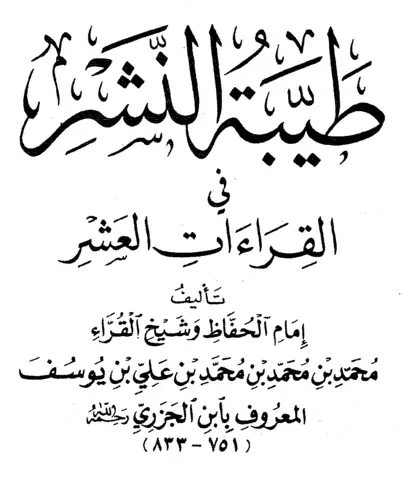|
|
القراءات : The readings
The readings of the Quran that where used by
the Prophet Muhammad, and which his companions
were receiving, were not confined to seven or ten
readings or even more.
So, the readings that the Prophet used and followed
by the Companions are not confined to seven
or ten.
The radings of the prophet became famous in
many places. The imams read what they hear,
and each one reads his friend's reading.
The error , melody and anomalies became praciced in
some readings.
Therefore, at the beginning of the third
century of Al-Hijra, the imams began to identify
acceptable reading, and not recommended ones.
The nation has agreed on three conditions, becoming
an accurate measure in accepting or refusing a reading.
These conditions are:
• First, every reading that is true that it comes from
Muhammad, the Messenger of Allaah.
• Second, the reading must agree with the books of the
Quran Writen by Othman Inb Affan, even with a certain
probability.
Thirdly, this reading have to agree with Arabic
language in a certain respectable and
significant way.
This is the correct reading, which is not permissible
to refute,and it is not permissible to deny.
1. Abu Ubayd al-Qasim :
the third century of Hijra
At the third century of Hijra ,
Abu Ubayd al-Qasim ibn Salam ibn
Abdullah al-Harawi al-Baghdadi
was the first imam to gather the readings
in a book called Alqiraat.
Abu Ubayd al-Qasim lived in the second and third
centuries (157 - 224 AH : 774 - 838 AD). He was born
in Herat, Afghanistan, and was buried in Mecca.
He was a world scholar, jurist, modernist and imam.
In his books Alqiraat , he gathered 25 readers,
including the 7 well known.
2. Ibnu Mujahid
Then came Ibnu Mujahid .
Ibn Mujahid: Abu Bakr Ahmad bin Musa al-Baghdadi
(245 - 324 AH = 859 - 936 AD).
He is Ahmed bin Musa bin Abbas al-Tamimi, Abu Bakr bin
Mujahid: the greatest scholar of the Quran in his time.
In his book «The Seven of the readings»
He is the first to limit the number of the
readers to the seven known, namely:
• 1. Nafie bin Abdulrahman Al-Leithi Al-madani
(dead: 169 AH).
نافع بن عبدالرحمن الليثي المدني
• 2. Abdullah bin Katheer ad-Dari al-Makki
(dead: 120 AH).
عبد الله بن كثير الدَّاري المكي
• 3. Zabban bin Alaa, Abu Amr Almazni visual
(dead: 154 AH).
َبَّان بن العلاء، أبو عمرو المازني البصري
• 4. Abdullah bin Amer al-Husseibi al-Shami
(dead: 118 AH).
عبد الله بن عامر اليحصبي الشامي
• 5. Asim bin Abi An-Najoud Al-Asadi Al-Kufi
(dead :128: AH).
عاصم بن أبي النُّجود الأسدي الكوفي
• 6. Hamza bin Habib al-Zayat al-Kufi
(dead. 156 AH).
حمزة بن حبيب الزيَّات الكوفي
• 7. Ali bin Hamza al-Nahawi known as Alksaai
(dead: 189 AH)
علي بن حمزة النحوي المعروف بالكسائي
3. Ibn al-Jazari
Then came Imam Ibn al-Jazari.
He is Mohammed bin Mohammed bin Mohammed bin Ali bin Yusuf
Known as Ibn Jazari
Ibn al-Jazari, the Sheikh of the readers
(751 - 833 AH : 1350 - 1429 AD.
He grew up in Damascus, where he memorized the Quran
and completed it when he was thirteen years old.
He excelled in the sciences of Tajweed and the arts
of readings, until the became Imam .
Ibn al-Jazari wrote two poetries regarding
the readings and recitation(tajweed) :
• 1. Durra Al-Maania : الدرة المعنية ,
in the readings of the three imams, and
• 2. Tayyibat An-Nashr : طيبة النشر
in the ten readings.
The Tayyibat is poetry that contains
1014 lignes.
4. The ten reading
Ibn al-Jazari completed the Ash-Shatibyya of Ash-Shatiby
that mentions 7 readings by his book Ad-Durra
that mentions 3 readings ,in order to obtain ten readings.
The set of these 10 reading are called the
The Ten Minor :
So The Ten Minor = Ash-Shatibyya +
Ad-Durra
In His book At-Tayyibat, he mentions theses 10
readings and added others, so :
So the Tayyibat = Ash-Shatibyya +
Ad-Durra + others,
The Tayyibat of the al-Jazari
is called The Big Ten .
The Big Ten = The Ten Minor +
others
It is called « Big Ten » because it contains 10
readings and much more ..
The three readings added in the poetry Ad-Durra
are:
• 1. The reading of Jacob Al-basri
(dead: 205 AH).
قراءة يعقوب البصري
. ت : 205هـ
• 2. The reading of Khalaf
(dead: 229 AH).
قراءة خلف
. ت : 229هـ
• 3. The reading of Abu Jaafar al-Madani
(dead: 128 AH).
قراءة أبو جعفر المدني
. ت : 128هـ

5. The remaining reading over
the islamic world
Only three readings of the Quran remain:
• 1. Millions of Muslims in all countries of the Islamic world read
Hafs from Aasim.
• 2. The Maghreb follows the reading of Imam
Warsh from Nafi.
• 3. In Sudan and Hadramout in Yemen they read
Imam ad-Douri, from Abu Amr al-Basri.


|

محتويات
الإدغام •
الترقيق والتفخيم •
أحكام القلقلة •
أحكام همزة الوصل •
الإخفاء •
صفات الحروف •
النون الساكنة والتنوين •
الإظهار •
الإدغام •
الإقلاب •
الإخفاء •
الميم الساكنة •
الإدغام •
الإخفاء •
الإظهار •
أحكام الميم والنون •
المشددتين
أحكام المدود •
المد الطبيعي •
المد الفرعي •
المد بسبب الهمز •
المد بسبب السكون •
مد العِوَض •
مد الصلة •
المقامات الموسيقية •
في تجويد القرءان
رواية ورش عن نافع •
متن الشاطبـــية •
القراءات القرآنية •
The readings •
© أحكام التجويد .
2006 - 2018
|